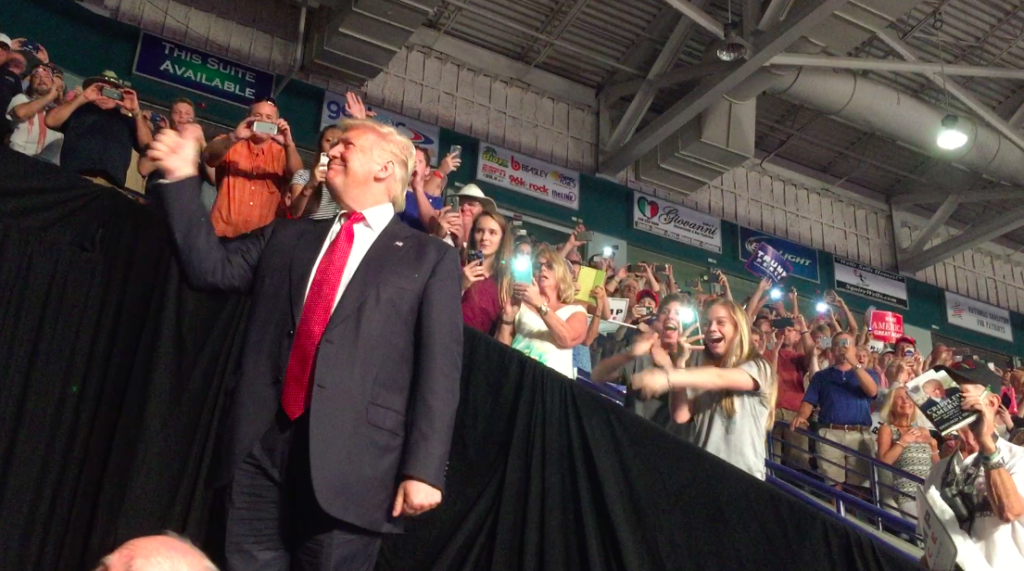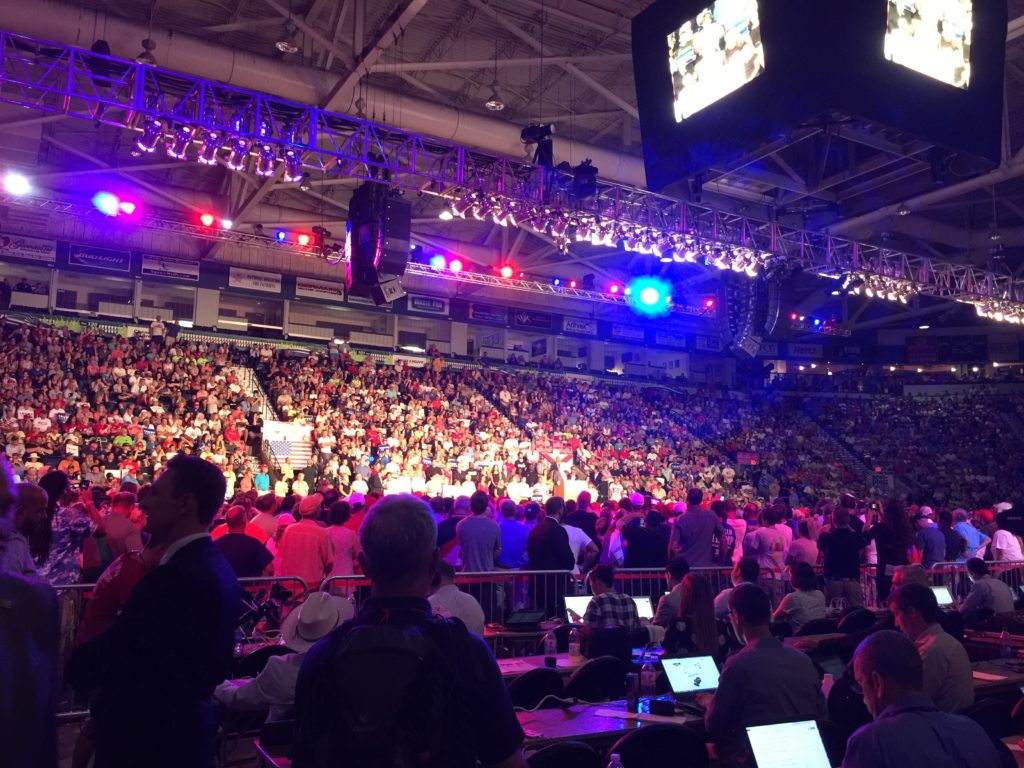Trump’s rally last week in Estero, Florida at Germain arena with 8,500 seats. Courtesy: David Martosko
- by sattkisson
The following is a news media analysis
Donald Trump has long complained that the news media refuses to show the size of his crowds. (Note: After interviewing him in Florida, we showed the crowd today on Full Measure.) Three questions are at issue: 1. Is the news media treating him differently? 2. How do Trump’s crowds compare to other candidates? 3. Does size matter?

1. Is the news media treating Trump differently? Yes. Trump is correct that the news media doesn’t often show his packed audiences. Neither do they remark much about the size of Hillary Clinton’s crowd. Is this because his audiences are large and hers are small?
A quick check shows the news media didn’t hesitate to publish glowing stories on Democrat Bernie Sanders’ crowds. The Washington Post called Sanders’ crowds “eye-popping.”
(Trump’s biggest crowds outweigh the ones mentioned as extraordinary in the Sanders article.) Oddly enough, in this August article, the Post noted Trump’s crowds without showing a single photograph of any of them.
Looking at the 2008 election, the news media frequently showed photos of then-Senator Obama’s audiences, which dwarfed those of his Republican candidate, John McCain. There were entire stories about the phenomenon.
“In crowd size, Obama has the edge,” reported the Wall Street Journal, noting that Obama ‘claimed the Democratic nomination before 17,000 people…with thousands more outside unable to get in,’ and ‘That same night, John McCain spoke to about 600 supporters.’”
CNN, The New York Times and Politico were among those that gushed about Obama’s huge crowds.
Of course, part of the reason could be because Obama was an historic candidate: the first black nominee, and his crowds were remarkable. For a reminder, check out the incredible photo at this New York Daily News link which reported a crowd of 65,000 in Portland, Oregon, with more left outside the gates. This article says Obama had 100,000 people gathered in Denver.
2. How do Trump’s crowds compare to others? In short, less than Obama’s massive 2008 crowds and, generally, more than Clinton’s and McCain’s. During the primary, Trump’s campaign routinely moved his rallies when the demand for tickets overwhelmed smaller venues. For example, a planned rally in Alabama at a Civic Center for 2,000 was moved at the last minute to a stadium twenty times bigger, where it’s estimated 20,000 turned out, half filling the venue.
When I interviewed Trump in Florida last week, he packed the Germain arena, which holds 8,500. Hillary’s speech around the same time at Temple University drew a group estimated at around 250. Many news articles seem to avoid using perspective photos that show Clinton’s entire crowd, and instead use shots that fill the camera shot with people. For example, if you relied on news reports, you might be convinced that Clinton’s Temple University audience was large. The New York Times used a photo shooting up at Clinton, showing people in a balcony as if there could be a giant crowd. A second photo made it appear as though there could be a large group of students in attendance, with a caption that read, “Mrs. Clinton spoke to a room filled with students at Temple University.” The Times avoided referencing the size of Clinton’s audience. I was unable to find a New York Times article referencing Trump’s Estero speech (pictured below). A local news station showed video inside and outside the Trump appearance, showing an overflow crowd.
3. Does size matter? Maybe. This is a tricky question. Much has been written on how much audience reflects on a candidate’s true popularity. One thing I would note is that Clinton has been making infrequent public appearances, and that her audiences are small, in part, by design. Her events appear to be set for modest venues, without a major effort put forth to attract a big crowd. Surely if an outreach had been made, more than 250 people would have come to see her at Temple University. It’s unclear why she would choose to appear before intimate groups in modest settings, but one should not conclude it’s because nobody else would attend.
The news media’s tendency during this particular campaign to avoid showing wide shots of either candidate’s audiences tends to work to Clinton’s advantage, since Trump’s enthusiastic, larger crowds would contrast with Clinton’s smaller groups.




No comments:
Post a Comment